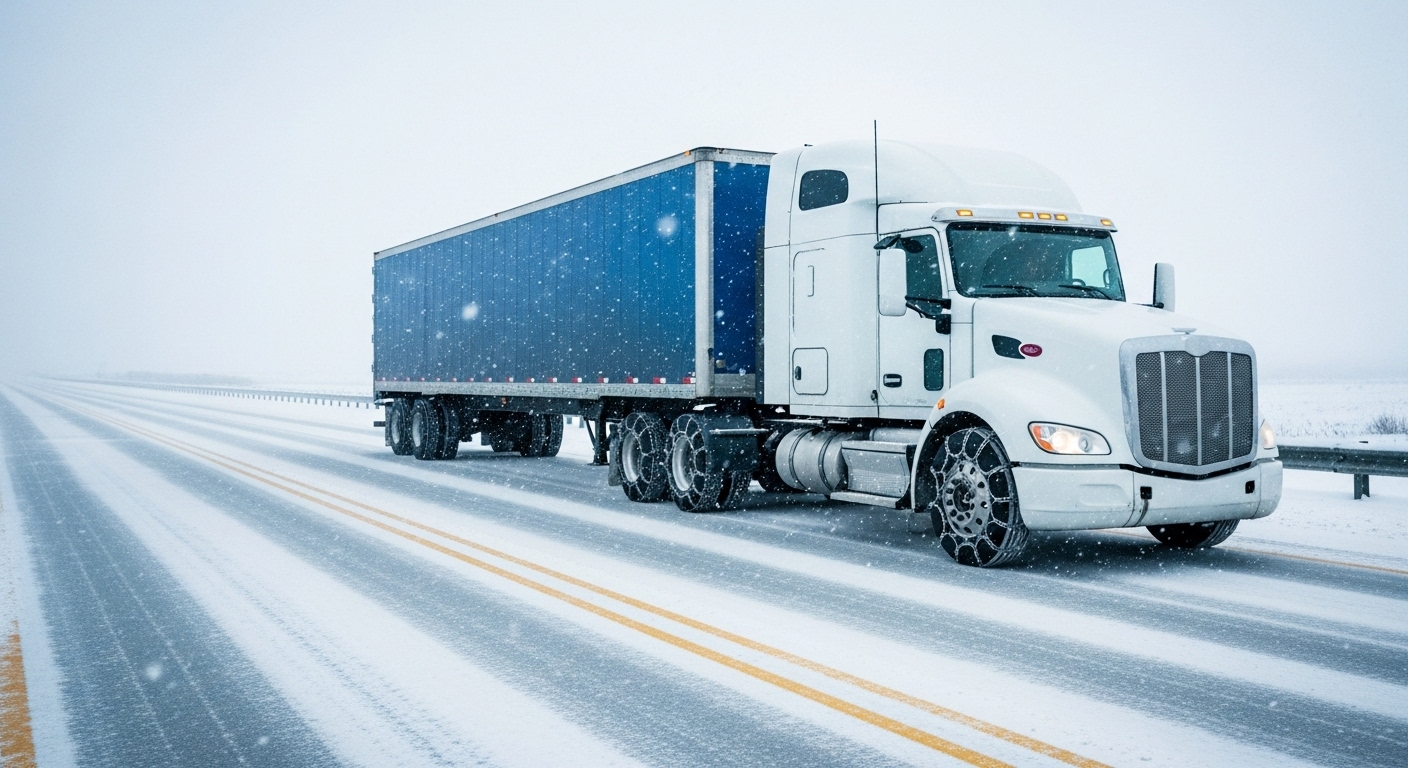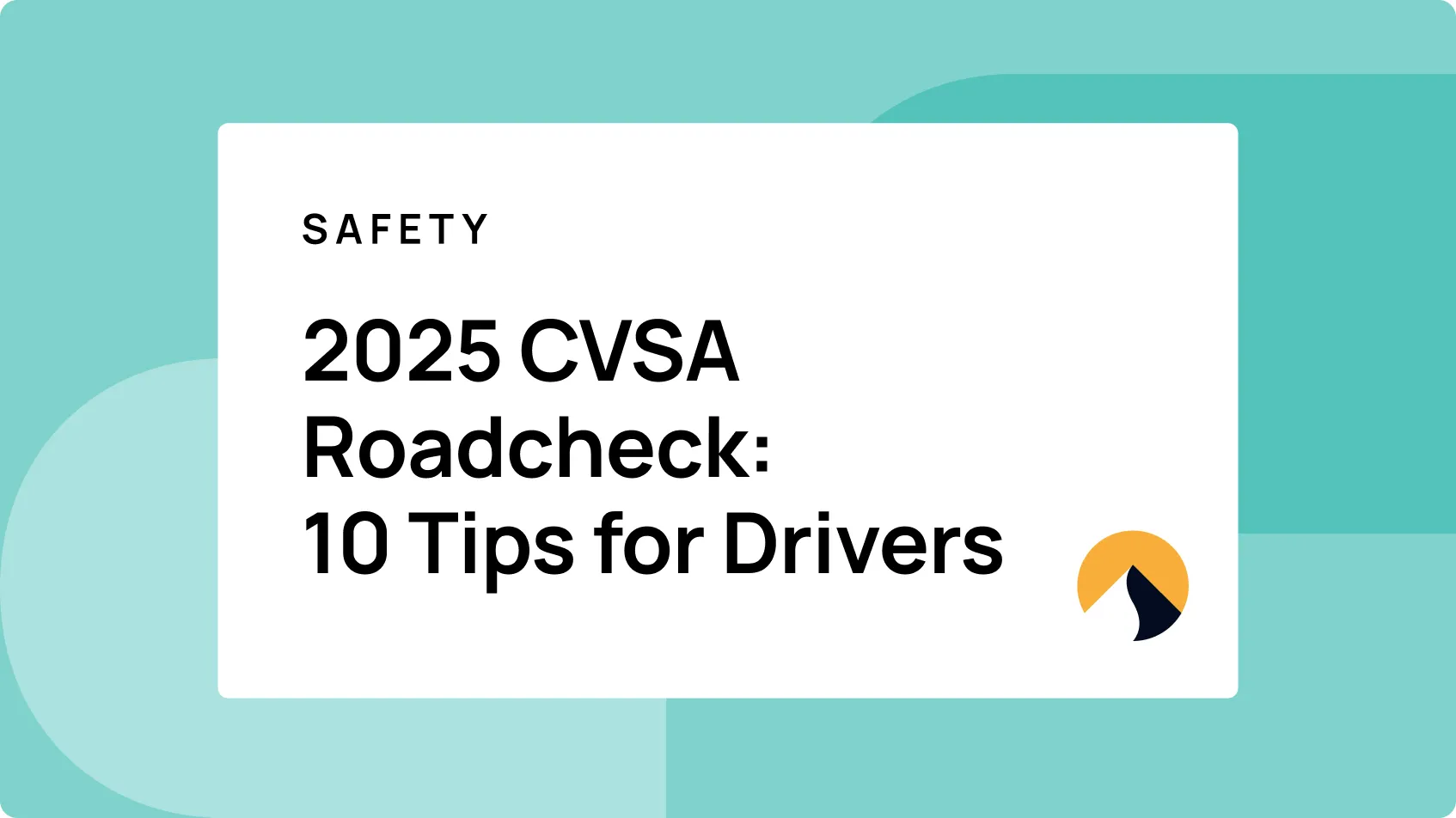Winter weather brings unique challenges for fleets, and as your trusted insurance partner, we’re here to help keep your operations safe and your drivers protected. Icy roads, limited visibility, and freezing temperatures all increase the risk of commercial vehicle collisions, which can have devastating consequences—not just for your business, but for the safety of your drivers and the public.
The good news? Many of these risks are preventable with the right preparation, habits, and decision-making. To help minimize accidents, injuries, and claims this winter, we’ve put together key tips for reducing the likelihood of weather-related collisions.
1. Prioritize pre-trip inspections
Pre-trip maintenance checks are even more critical during winter. Many accidents can be prevented by catching mechanical issues or potential hazards before they become problems on the road. Make sure your fleet adheres to consistent inspections, paying close attention to winter-specific concerns:
- Tires: Proper inflation and tread depth are vital for maintaining traction on icy roads. Use winter-specific tires in regions prone to heavy snow or ice.
- Brakes: Fully functioning brakes are non-negotiable. Ensure brake pads aren’t worn, and verify that air brake lines are free from moisture to prevent freezing.
- Lights and windshield wipers: Ensure all lights, including headlights and brake lights, are working to improve visibility for your drivers and others on the road. Winter-grade windshield wipers and de-icing washer fluid are also critical to maintaining clear sightlines during snow or freezing rain.
- Emergency supplies: Stock vehicles with essentials like flares, reflective triangles, blankets, food, water, and a first aid kit in case of unexpected delays due to severe weather.
Proper inspections aren’t just about compliance—they’re about safety. Encourage your drivers to report any issues immediately and to never hit the road with compromised equipment.
2. Reinforce safe driving practices
Speeding, tailgating, and abrupt braking are major contributors to winter road accidents, and the risk is even greater for large commercial vehicles. Your drivers play the most critical role in accident prevention, so ongoing training and reminders about safe practices are essential.
Encourage drivers to:
- Drive slower than speed limit: Speed limits are designed for normal road conditions, not snow or ice. Advise drivers to reduce speeds and increase following distances, giving them ample time to respond to sudden stops or road hazards.
- Avoid sudden movements: Teach drivers to accelerate, decelerate, and change lanes smoothly to avoid losing traction on slippery roads.
- Increase awareness on bridges and ramps: Remind drivers that black ice often forms on bridges, overpasses, and shaded areas, even when the rest of the road seems clear.
Regular training refreshers can help drivers stay vigilant and build good habits that reduce the potential for claims and liability.
3. Monitor weather conditions and communicate proactively
Unpredictable winter storms can quickly change road conditions and put drivers in dangerous situations. Proactive communication about weather conditions and route planning can make all the difference. As part of your risk management program, encourage drivers to:
- Use real-time GPS and weather apps to check road conditions before and during trips.
- Share regular updates with dispatchers so they can reroute trips around storms, road closures, or hazardous areas.
- Understand the company’s policy on delaying trips or pulling over in severe weather. Make it clear that safety takes priority over deadlines.
When drivers feel supported and understand that stopping to wait out a storm is not only acceptable but encouraged, they’re less likely to take dangerous risks.
4. Equip and train drivers for winter emergencies
Despite the best preparation, emergencies can happen. To prevent minor issues from escalating into major losses, ensure your drivers know what to do in the event of a breakdown, skid, or crash:
- Skidding: Reinforce the importance of staying calm and steering gently into a skid rather than overcorrecting. If the truck is equipped with anti-lock brakes (ABS), instruct drivers to apply firm, steady pressure.
- Breakdowns: Advise drivers to pull over to a safe space, such as a rest area or wide shoulder, and to deploy warning triangles or flares to alert other drivers. Remind them to avoid standing outside the truck near busy highways.
- Accidents: Train drivers to prioritize safety first, call law enforcement, and document the scene with photos where possible. Teach them to follow company protocols for reporting incidents promptly to reduce delays in resolving claims.
Prepared and confident drivers are less likely to panic and make costly mistakes in emergencies.
5. Encourage safe parking practices
Parking safely during winter weather can prevent secondary collisions, a common cause of claims. When drivers must stop due to poor weather, ensure they understand the importance of choosing secure locations:
- Pilot your trucks toward designated rest areas or truck stops instead of pulling over on the shoulder, which increases the risk of being struck by other vehicles.
- Use reflective safety gear if exiting the vehicle.
- Never park beneath overpasses or on steep grades where snow or ice may fall unexpectedly.
Knowing when to stop driving is just as important as knowing how to drive. Empower your drivers to make smart decisions to protect themselves and others.
6. Review your winter weather policy as a team
Does your team have a clear, actionable winter weather policy in place? If not, now is the time to develop or strengthen one. Your policy should include:
- Guidelines for when drivers are encouraged to delay trips due to weather conditions.
- Expectations for safe driving speeds, breaking, and maneuvering.
- Information on how to report accidents, breakdowns, or hazardous conditions.
We also recommend open communication with your drivers about the importance of safety policies. Encourage feedback and reinforce that these measures protect not just the company’s assets, but also your drivers’ lives.
Winter weather brings unique challenges for fleets, and as your trusted insurance partner, we’re here to help keep your operations safe and your drivers protected. Icy roads, limited visibility, and freezing temperatures all increase the risk of commercial vehicle collisions, which can have devastating consequences—not just for your business, but for the safety of your drivers and the public.
The good news? Many of these risks are preventable with the right preparation, habits, and decision-making. To help minimize accidents, injuries, and claims this winter, we’ve put together key tips for reducing the likelihood of weather-related collisions.
1. Prioritize pre-trip inspections
Pre-trip maintenance checks are even more critical during winter. Many accidents can be prevented by catching mechanical issues or potential hazards before they become problems on the road. Make sure your fleet adheres to consistent inspections, paying close attention to winter-specific concerns:
- Tires: Proper inflation and tread depth are vital for maintaining traction on icy roads. Use winter-specific tires in regions prone to heavy snow or ice.
- Brakes: Fully functioning brakes are non-negotiable. Ensure brake pads aren’t worn, and verify that air brake lines are free from moisture to prevent freezing.
- Lights and windshield wipers: Ensure all lights, including headlights and brake lights, are working to improve visibility for your drivers and others on the road. Winter-grade windshield wipers and de-icing washer fluid are also critical to maintaining clear sightlines during snow or freezing rain.
- Emergency supplies: Stock vehicles with essentials like flares, reflective triangles, blankets, food, water, and a first aid kit in case of unexpected delays due to severe weather.
Proper inspections aren’t just about compliance—they’re about safety. Encourage your drivers to report any issues immediately and to never hit the road with compromised equipment.
2. Reinforce safe driving practices
Speeding, tailgating, and abrupt braking are major contributors to winter road accidents, and the risk is even greater for large commercial vehicles. Your drivers play the most critical role in accident prevention, so ongoing training and reminders about safe practices are essential.
Encourage drivers to:
- Drive slower than speed limit: Speed limits are designed for normal road conditions, not snow or ice. Advise drivers to reduce speeds and increase following distances, giving them ample time to respond to sudden stops or road hazards.
- Avoid sudden movements: Teach drivers to accelerate, decelerate, and change lanes smoothly to avoid losing traction on slippery roads.
- Increase awareness on bridges and ramps: Remind drivers that black ice often forms on bridges, overpasses, and shaded areas, even when the rest of the road seems clear.
Regular training refreshers can help drivers stay vigilant and build good habits that reduce the potential for claims and liability.
3. Monitor weather conditions and communicate proactively
Unpredictable winter storms can quickly change road conditions and put drivers in dangerous situations. Proactive communication about weather conditions and route planning can make all the difference. As part of your risk management program, encourage drivers to:
- Use real-time GPS and weather apps to check road conditions before and during trips.
- Share regular updates with dispatchers so they can reroute trips around storms, road closures, or hazardous areas.
- Understand the company’s policy on delaying trips or pulling over in severe weather. Make it clear that safety takes priority over deadlines.
When drivers feel supported and understand that stopping to wait out a storm is not only acceptable but encouraged, they’re less likely to take dangerous risks.
4. Equip and train drivers for winter emergencies
Despite the best preparation, emergencies can happen. To prevent minor issues from escalating into major losses, ensure your drivers know what to do in the event of a breakdown, skid, or crash:
- Skidding: Reinforce the importance of staying calm and steering gently into a skid rather than overcorrecting. If the truck is equipped with anti-lock brakes (ABS), instruct drivers to apply firm, steady pressure.
- Breakdowns: Advise drivers to pull over to a safe space, such as a rest area or wide shoulder, and to deploy warning triangles or flares to alert other drivers. Remind them to avoid standing outside the truck near busy highways.
- Accidents: Train drivers to prioritize safety first, call law enforcement, and document the scene with photos where possible. Teach them to follow company protocols for reporting incidents promptly to reduce delays in resolving claims.
Prepared and confident drivers are less likely to panic and make costly mistakes in emergencies.
5. Encourage safe parking practices
Parking safely during winter weather can prevent secondary collisions, a common cause of claims. When drivers must stop due to poor weather, ensure they understand the importance of choosing secure locations:
- Pilot your trucks toward designated rest areas or truck stops instead of pulling over on the shoulder, which increases the risk of being struck by other vehicles.
- Use reflective safety gear if exiting the vehicle.
- Never park beneath overpasses or on steep grades where snow or ice may fall unexpectedly.
Knowing when to stop driving is just as important as knowing how to drive. Empower your drivers to make smart decisions to protect themselves and others.
6. Review your winter weather policy as a team
Does your team have a clear, actionable winter weather policy in place? If not, now is the time to develop or strengthen one. Your policy should include:
- Guidelines for when drivers are encouraged to delay trips due to weather conditions.
- Expectations for safe driving speeds, breaking, and maneuvering.
- Information on how to report accidents, breakdowns, or hazardous conditions.
We also recommend open communication with your drivers about the importance of safety policies. Encourage feedback and reinforce that these measures protect not just the company’s assets, but also your drivers’ lives.












